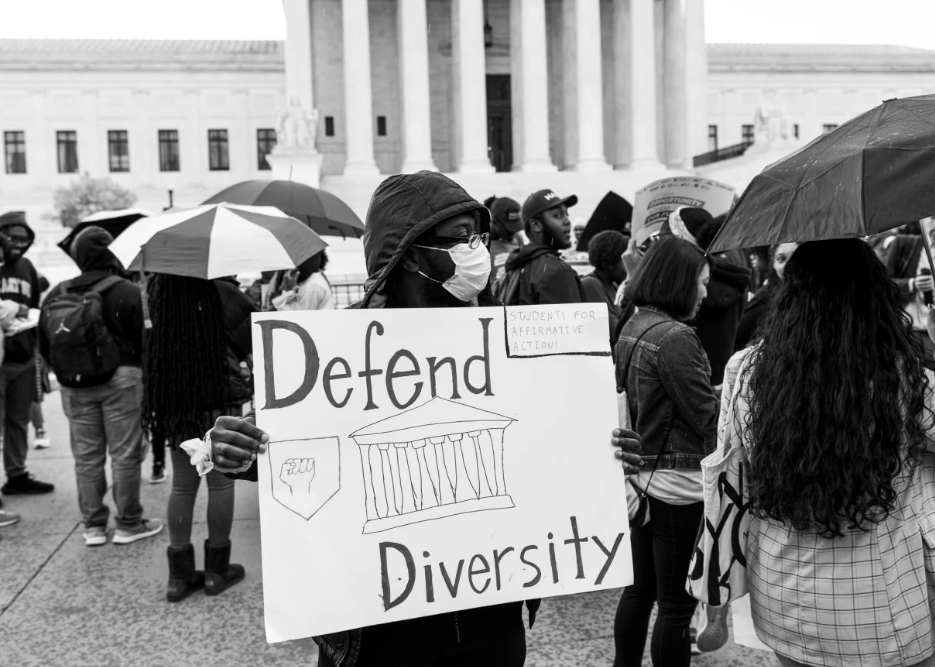Supreme Court’s Decision on Affirmative Action: A Gross Miscarriage of Justice
Today’s Supreme Court decisions on affirmative action admissions programs at the University of North Carolina and Harvard College have sent shockwaves through the nation. These decisions, claiming that past injustices have no impact on present and future inequalities, represent a perjury by the court’s majority. It is a betrayal of America’s past, present, and future.
Affirmative action, for me as a person of faith, is a tool of justice. It is a means to overcome discrimination and lies, aligning with the biblical call for love, truth, mercy, and grace. However, the Supreme Court’s decision to upend affirmative action in college admissions not only violates the moral vision of the Bible but also the U.S. Constitution.
The 14th Amendment, designed to ensure equal protection under the law after slavery, has been abused by the majority of the court. Edward Blum, the man behind this case, pitted minority groups against each other, creating a divisive narrative. Asian students complained they did not get into Harvard and UNC because of favoritism towards Black students and Latinos. This case has turned a crucial issue into a racial battleground.
Chief Justice John Roberts and Justice Clarence Thomas, the authors of the majority and concurring opinions, respectively, seem to believe that the damage caused by centuries of slavery and Jim Crow can be undone without further action. This dangerous belief could pave the way for rolling back protections for women, the disabled, and other marginalized groups.
Thomas, who himself benefited from affirmative action, now claims it goes against our colorblind Constitution and equality ideal. This self-hatred is insidious and requires a divine change of heart.
A recent study by the Brookings Institution reveals a persistent gap in college admissions between white students and their Black and Latino peers, even with the same academic preparation. Today’s ruling is an outrage in light of this reality. It promotes the false notion that success is solely the result of individual choices and ignores the impact of social structures.
We must not forget the sacrifices of our ancestors. They fought for justice, and now it is our turn to mobilize. African Americans and all justice-loving people must unite in a massive fusion coalition that can impact every race in the country. We must put extremists out of office and demand immediate action from Congress to fix voting rights, affirmative action, living wages, and a woman’s right to choose.
Racism is far from over. Discriminatory policies with racist intent are still being passed in our state legislature. The Supreme Court’s decision that affirmative action is no longer necessary contradicts its own ruling from just six years ago, which found that our state’s legislature targeted African Americans with voter suppression legislation.
Affirmative action is not about feelings; it is about addressing hard facts and dismantling structures that perpetuate inequality. It is about ensuring equal opportunity for all Americans. Today’s decision takes away the possibility of considering a history of disadvantage during admissions decisions, a gross miscarriage of justice.
This decision will have an immediate impact on Black and Latino students and families, but its long-term effects on the nation will be devastating. However, we must remember that extreme decisions can serve as a wake-up call for justice-loving people. We cannot give up. We must keep standing, speaking truth, and mobilizing. Just as bad decisions of the past were eventually overturned, we will overcome this decision too.
The Rev. Dr. William Barber, founding director of the Center for Public Theology and Public Policy at Yale Divinity School, urges us to continue the fight for justice and equality.
The Supreme Court’s Controversial Decision: Unveiling the Truth Behind Affirmative Action’s Replacement
Introduction
Affirmative action has long been a contentious issue in the United States, with proponents arguing that it is necessary to address historical inequalities, while opponents claim it perpetuates discrimination. Recently, the Supreme Court made a controversial decision regarding affirmative action, leading to the implementation of a replacement policy. This article aims to shed light on the truth behind this decision and its potential implications for the future.
Background
Affirmative action was introduced in the 1960s as a means to combat discrimination and promote equal opportunities for historically marginalized groups, particularly African Americans and women. It aimed to rectify the imbalances caused by centuries of systemic racism and sexism. However, over the years, affirmative action has faced numerous legal challenges, with opponents arguing that it violates the principle of equal protection under the law.
The Supreme Court’s Decision
In a landmark ruling, the Supreme Court recently decided to replace affirmative action with a new policy that seeks to address the same issues but in a different manner. The decision was met with both praise and criticism, highlighting the deeply divided opinions on this matter.
The replacement policy, known as “merit-based admissions,” aims to ensure that all applicants are evaluated solely on their individual merits, without considering their race or gender. Proponents argue that this approach promotes fairness and equal treatment for all, as it eliminates any potential bias in the admissions process. They believe that this new policy will create a level playing field, where individuals are judged solely on their abilities and qualifications.
Critics, however, argue that the replacement policy fails to acknowledge the systemic disadvantages faced by historically marginalized groups. They contend that by removing race and gender from the equation, the new policy overlooks the need for targeted measures to address the historical inequities that persist in society. Critics fear that this decision may lead to a regression in the progress made towards achieving true equality.
Implications and Potential Consequences
The Supreme Court’s decision to replace affirmative action with a merit-based admissions policy has far-reaching implications for higher education institutions and society as a whole. One potential consequence is a decrease in diversity on college campuses. Affirmative action was designed to promote diversity by ensuring representation from all backgrounds, which enriches the educational experience and prepares students for a diverse workforce. Without such measures, universities may become less diverse, hindering the development of well-rounded individuals.
Furthermore, the replacement policy may inadvertently perpetuate existing inequalities. By solely focusing on individual merits, it fails to consider the socio-economic disadvantages faced by certain groups. Research has shown that individuals from disadvantaged backgrounds often have fewer opportunities to excel academically, leading to a potential bias against them in a merit-based system. This could result in a further marginalization of historically underrepresented groups.
Conclusion
The Supreme Court’s decision to replace affirmative action with a merit-based admissions policy has sparked intense debate and raised important questions about the future of equal opportunity in the United States. While proponents argue that the new policy promotes fairness and equal treatment, critics fear that it may perpetuate existing inequalities and hinder progress towards true equality. As the implementation of this replacement policy unfolds, it is crucial to closely monitor its impact and ensure that it does not undermine the principles of justice and equal opportunity that affirmative action sought to address.









